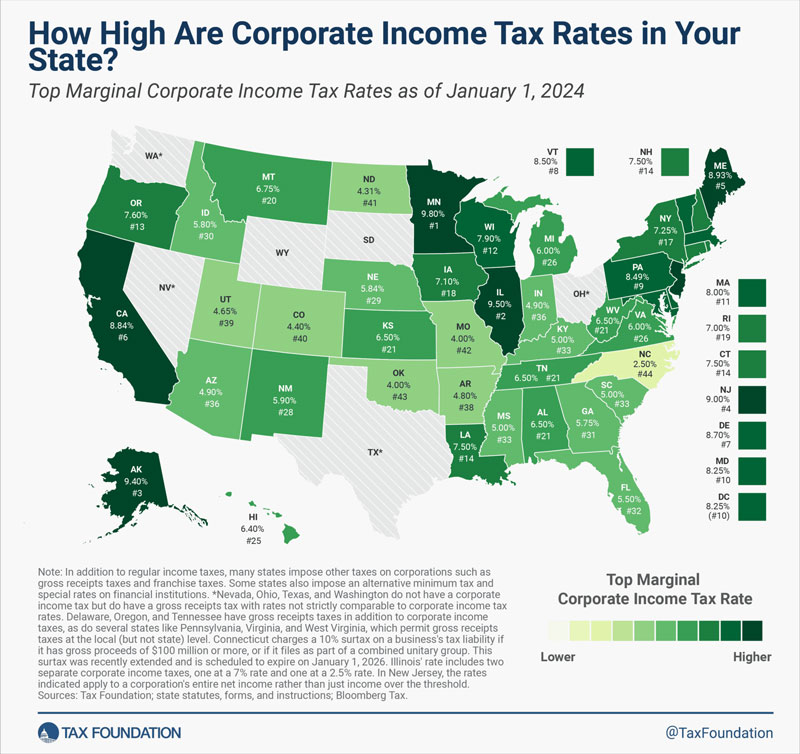Key Findings
- Forty-four states levy a corporate income tax. Top rates range from a 2.5 percent flat rate in North Carolina to a 9.8 percent top marginal rate in Minnesota.
- Four states—Alaska, Illinois, Minnesota, and New Jersey—levy top marginal corporate income tax rates of 9 percent or higher.
- Twelve states—Arizona, Arkansas, Colorado, Indiana, Kentucky, Mississippi, Missouri, North Carolina, North Dakota, Oklahoma, South Carolina, and Utah—have top rates at or below 5 percent.
- Nevada, Ohio, Texas, and Washington impose gross receipts taxes instead of corporate income taxes. Delaware, Oregon, and Tennessee impose gross receipts taxes in addition to their corporate income taxes. Some localities in Pennsylvania, Virginia, and West Virginia likewise impose gross receipts taxes, which are generally understood to be more economically harmful than corporate income taxes.
- South Dakota and Wyoming are the only states that levy neither a corporate income nor gross receipts tax.
Corporate income taxes are levied in 44 states. Though often thought of as a major tax type, corporate income taxes accounted for only 7.07 percent of state tax collections and 3.32 percent of state general revenue in fiscal year (FY) 2021. And while these figures are not high, they represent a substantial increase over prior years. Corporate income taxes accounted for 2.27 percent of general revenue in FY 2020, which is more in line with historical norms.
Minnesota levies the highest top statutory corporate tax rate at 9.8 percent, followed by Illinois (9.5 percent) and Alaska (9.4 percent). New Jersey, which levied the highest corporate rate in the country of 11.5 percent from 2021-2023, now has the fourth-highest rate (9 percent), as the state’s 2.5 percentage-point corporation business tax surcharge expired at the end of 2023. Going back several years, Iowa shed a top marginal rate of 12 percent (albeit with deductibility for federal taxes paid) and Pennsylvania began phasing its 9.99 percent rate down to—eventually—4.99 percent.
Conversely, North Carolina’s flat rate of 2.5 percent is the lowest in the country, followed by rates in Missouri and Oklahoma (both at 4 percent) and North Dakota (4.31 percent). Eight other states impose top rates at or below 5 percent: Colorado (4.4 percent), Utah (4.65 percent), Arkansas (4.8 percent), Arizona and Indiana (4.9 percent), and Kentucky, Mississippi, and South Carolina (5 percent).
Nevada, Ohio, Texas, and Washington forgo corporate income taxes but instead impose gross receipts taxes on businesses, which are generally thought to be more economically harmful due to tax pyramiding, disparate impacts on low-margin businesses, and non-transparency. In Nevada and Ohio, however, these taxes are imposed at relatively low rates, and this year, Ohio implemented new thresholds that exempt many smaller businesses from gross receipts taxation. Delaware, Oregon, and Tennessee impose gross receipts taxes in addition to corporate income taxes, and several additional states—Pennsylvania, Virginia, and West Virginia—permit gross receipts taxes at the local (but not state) level. South Dakota and Wyoming levy neither corporate income nor gross receipts taxes, and with the enactment of a budget in 2021 that includes the multiyear phaseout of its corporate income tax, North Carolina is due to join them by 2030.
Twenty-nine states and the District of Columbia have single-rate corporate tax systems. The greater propensity toward single-rate systems for corporate tax than individual income tax is likely because there is no meaningful “ability to pay” concept in corporate taxation. Jeffrey Kwall, professor of law at Loyola University Chicago School of Law, notes that:
Graduated corporate rates are inequitable—that is, the size of a corporation bears no necessary relation to the income levels of the owners. Indeed, low-income corporations may be owned by individuals with high incomes, and high-income corporations may be owned by individuals with low incomes.
A single-rate system minimizes the incentive for firms to engage in economically wasteful tax planning to mitigate the damage of higher marginal tax rates that some states levy as taxable income rises.
Notable State Corporate Income Tax Changes for 2024
Numerous states have enacted corporate income tax rate changes over the past few years. The following corporate income tax rate changes—which are all rate reductions rather than increases—took effect on January 1, 2024.
Arkansas
In recent years, Arkansas has taken great strides to improve its tax competitiveness by reducing income tax rates and consolidating brackets. That progress is continuing in 2024 with the elimination of Arkansas’s top corporate income tax bracket and the reduction of the top marginal rate from 5.1 percent for tax year 2023 to 4.8 percent for tax year 2024. This change is the result of S.B. 8, enacted in September 2023, which accelerated previously planned individual and corporate income tax rate reductions. Prior to the passage of S.B. 8, legislation enacted in April 2023 retroactively reduced Arkansas’s top marginal corporate income tax rate from 5.3 to 5.1 percent for 2023. Preceding those reforms, Arkansas’s top marginal rate was 5.9 percent in 2022, 6.2 percent in 2021, and 6.5 percent in many years prior.
Iowa
Iowa’s recent comprehensive tax reforms—adopted in 2018, 2021, and 2022—are continuing to phase in this year with the state’s top marginal corporate income tax rate decreasing from 8.4 percent in 2023 to 7.1 percent in 2024. Under current law, Iowa’s corporate rate will continue decreasing over time, subject to revenue availability, until it reaches a flat 5.5 percent. These rate reductions have contributed to a remarkable improvement in Iowa’s tax competitiveness. Prior to the implementation of the 2018 reforms, Iowa had the highest top marginal corporate income tax rate in the country at 12 percent.
Kansas
Kansas is another state that saw a corporate income tax rate reduction at the beginning of the year. Kansas levies what is functionally a two-rate corporate income tax, though it is implemented as a set statutory rate with a 3 percentage-point surtax on corporate taxable income in excess of $50,000. Through 2023, the statutory rate was 4 percent, meaning businesses exposed to the 3-percentage point surtax paid a top marginal rate of 7 percent. Beginning in 2024, the statutory rate has been reduced to 3.5 percent, meaning the top marginal rate for businesses exposed to the 3 percentage-point surtax is now 6.5 percent. This change is the result of an economic development incentive bill enacted in 2022 that requires a 0.5 percentage-point reduction to the statutory rate in any year in which the Kansas Secretary of Commerce certifies that a qualified firm began construction on a qualified business facility in Kansas during the previous year, designed to tie rate reductions to successfully attracting major new businesses to the state.
Nebraska
Nebraska has made pro-growth tax reform a priority in recent years and is in the process of phasing down its corporate income tax to a flat 3.9 percent by 2027. As of January 1, 2024, the top marginal corporate income tax rate experienced a significant reduction from 7.25 to 5.84 percent, reaching that target top marginal rate three years earlier than initially planned. This is the result of LB 754, enacted in May 2023, which accelerated previously enacted reductions to Nebraska’s corporate and individual income taxes. Next year, Nebraska’s corporate income tax rate is scheduled to be converted from a two-rate tax to a flat 5.2 percent tax, and the flat rate is scheduled to decrease to 4.55 percent in 2026 and 3.99 percent in 2027.
New Jersey
After being in effect for six years, New Jersey’s temporary 2.5 percentage-point corporation business tax surcharge was allowed to expire at the end of 2023, resulting in the reduction of New Jersey’s top marginal corporate income tax rate from 11.5 percent in 2023 to 9 percent in 2024. Previously, this surcharge applied to business income exceeding $1 million. As a result, New Jersey went from having the highest top marginal corporate income tax rate in the country in 2023 to the fourth highest this year.
Pennsylvania
Pennsylvania’s corporate net income tax rate remains on a downward trajectory, decreasing from 8.99 percent in 2023 to 8.49 percent in 2024. This change is the result of H.B. 1342, enacted in July 2022, which reduced the rate from 9.99 percent in 2022 to 8.99 percent in 2023 and prescribed future reductions of 0.5 percentage points each year until the rate reaches 4.99 percent in 2031.
Retroactive Changes
In addition to these changes in January 2024, Utah’s corporate income tax rate was reduced from 4.85 to 4.65 percent, retroactively effective as of January 1, 2023, as a result of H.B. 54, enacted in March 2023, after our prior edition of this publication. This follows similar legislation that was enacted in 2022 to reduce the corporate rate from 4.95 to 4.85 percent, retroactively effective as of January 1, 2022.
2024 State Corporate Income Tax Rates

State Corporate Income Tax Rates as of January 1, 2024
(a) Connecticut charges a 10% surtax on a business's tax liability if it has gross proceeds of $100 million or more, or if it files as part of a combined unitary group. This surtax was recently extended and is scheduled to expire on January 1, 2026.
(b) Nevada, Ohio, Texas, and Washington do not have a corporate income tax but do have a gross receipts tax with rates not strictly comparable to corporate income tax rates. Delaware, Oregon, and Tennessee have gross receipts taxes in addition to corporate income taxes, as do several states like Pennsylvania, Virginia, and West Virginia, which permit gross receipts taxes at the local (but not state) level.
(c) Georgia's corporate income tax rate is scheduled to revert to 6% on January 1, 2026.
(d) Illinois' rate includes two separate corporate income taxes, one at a 7% rate and one at a 2.5% rate.
(e) In New Jersey, the rates indicated apply to a corporation's entire net income rather than just income over the threshold.
Note: In addition to regular income taxes, many states impose other taxes on corporations such as gross receipts taxes and capital stock taxes. Some states also impose an alternative minimum tax and special rates on financial institutions.
Sources: Tax Foundation; state tax statutes, forms, and instructions; Bloomberg Tax.
















